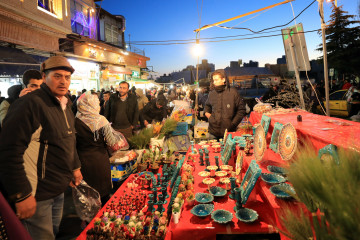

Spring is in the air in Washington, as Iranians, Afghans and others of central Asian heritage are getting ready for Nowruz, the Zoroastrian new year celebration marked on the first day of spring.
The holiday – much like the new spring season – symbolises renewal, nature, reconciliation, shedding the old and moving on with the new
Bazaars selling crafts and food, family picnics, and community gatherings are all part of a week-long celebration of Nowruz in Washington DC, Maryland and Virginia, as the holiday continues to gain traction in the US, particularly in areas like the Mid-Atlantic with high populations of Iranians and Afghans.
|
The holiday – much like the new spring season – symbolises renewal, nature, reconciliation, shedding the old and moving on with the new.
“Last year has seen a lot of challenges and dark times,” Kowsar Gowhari, a refugee case manager, tells The New Arab. “I’m sure this Nowruz will bring a good spirit. I know a lot of good things are just waiting to happen.”
The universal theme of Nowruz, celebrated by more than 300 million people from central Asia to eastern Europe, and in their diasporas across the world, is giving observants who want to spread the holiday hope that it can have wider appeal.
This year, the Washington, DC Council passed a resolution recognising Nowruz (choosing the most standard spelling used in English). Drafted by local members of the Iranian community, the resolution highlights the holiday's ancient traditions and its ideals of community and natural environment.
The statement notes that the tradition goes back more than 3,000 years, it is recognised by the United Nations, it is a symbol of renewal, and it is celebrated across religious faiths. It also notes the large Afghan community in the Washington, DC area.
|
"There's a large population of Afghan refugees settling in the DC area. We thought this would be a warm welcome,” Negar Mortazavi, a journalist and a member of the Washington, DC area's Iranian community who helped draft the resolution, tells The New Arab.
"We put an emphasis on this being a very ancient and historic holiday celebrated by a diversity of people, even a diversity of religions," she says, noting that they didn’t want it to be Iranian-centric, so as to make it open to all and to acknowledge the other communities that celebrate it.
“Ever since the evacuation of Kabul, I’ve seen a lot of folks coming together to welcome refugees,” Niki Akhavan, an associate professor of media studies at Catholic University, tells The New Arab. “They’ve put together packages for families, volunteered as translators. There are so many great things people are doing.”
She says, “On a symbolic level, what’s something someone entering into a community can have to feel welcome? Recognition of customs.”
"My goal or dream is for Nowruz to go beyond our community. It has so many universal values. You don’t have to grow up with it"
For Sara Amiry, a refugee case manager who came to the US from Afghanistan 10 years ago, the holiday is still a niche event where observants celebrate among themselves.
“For me, the area of the street where we lived, everyone would celebrate. We’d visit each other’s houses. Sometimes we’d have cultural events in a park,” she tells The New Arab of her younger years in Afghanistan. “It’s definitely different here. When we go out, we don’t see a lot of people celebrating.”
If Mortazavi has her way, these celebrations will become a part of America’s general year-round holidays.
“My goal or dream is for Nowruz to go beyond our community. It has so many universal values. You don’t have to grow up with it,” says Mortazavi, likening it to the Lunar New Year or Diwali, holidays that have expanded beyond their communities of origin in recent years.
“I want it to become mainstream. I think it’s very universal. It’s an ancient holiday, but it’s so modern because we now have this environmental problem. I think it has potential.”




 Follow the Middle East's top stories in English at The New Arab on Google News
Follow the Middle East's top stories in English at The New Arab on Google News


